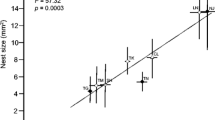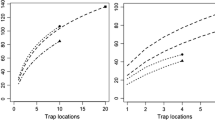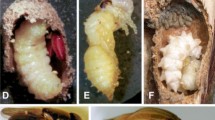Summary
While a number of advantages may result from group living, it may also lead to increased levels of attack by parasites because groups may be easier to find. This leads to the prediction that levels of parasitism should increase with colony size. We test this prediction by comparing colony size and parasitoid load for two species of colonial orb-weaving spiders from Mexico, Metepeira (undesc. sp., tentatively named atascadero) and Metepeira incrassata, which exhibit contrasting levels of social organization and utilize different habitats. For M. atascadero, which occurs solitarily or in small groups in desert/mesquite grassland habitat, rates of egg-sac parasitism fluctuate widely from year to year, and are closely tied to spider egg output. There is no relationship between colony size and rate of parasitism. For colonial M. incrassata, which occur in tropical rain forest/agricultural habitat, rates of parasitism are relatively constant from year to year. However, there is a positive relationship between colony size and rate of parasitism in this species. These differences are discussed with regard to the stability of the two habitats, prey availability, and the foraging behavior of the respective parasitoids.
Similar content being viewed by others
References
Alcock J (1989) Animal behavior, 4th ed. Sinauer Associates, Boston
Alexander RD (1974) The evolution of social behavior. Ann Rev Ecol Syst 5:325–383
Benton MJ, Uetz GW (1986) Variation in life history characteristics over a clinal gradient in three populations of a communal orb-weaving spider. Oecologia 68:395–399
Brown JL, Orians GH (1970) Spacing patterns in mobile animals. Ann Rev Ecol Syst 1:239–262
Burgess JW, Uetz GW (1982) Social spacing strategies in spiders. In: Witt PN, Rovner JS (eds) Spider communication, mechanisms and ecological significance. Princeton University Press, Princeton, pp 317–347
Burgess JW, Witt PN (1976) Spider webs: design and engineering. Interdisc Sci Rev 1:322–355
Buskirk RE (1981) Sociality in the Arachnida. In: Hermann HR (ed) Social Insects, vol II. Academic Press, New York, pp 281–359
Cangialosi KR, Uetz GW (1987) Spacing in colonial spiders: effects of environment and experience. Ethology 76:236–246
Hamilton WD (1971) Geometry for the selfish herd. J Theor Biol 31:295–311
Inman AJ, Krebs J (1987) Predation and group living. Trends Ecol Evol 2:31–32
Lubin YD (1974) Adaptive advantages and the evolution of colony formation in Cyrtophora (Araneae: Araneidae). Zool J Linn Soc 54:321–339
Michener CD (1974) The social behavior of bees. Harvard University Press, Cambridge
Nentwig W (1985) Social spiders catch larger prey: a study of Anelosimus eximus (Araneae: Theridiidae). Behav Ecol Sociobiol 17:79–85
Pulliam HR (1973) On the advantage of flocking. J Theor Biol 38:419–422
Pulliam HR, Caraco T (1984) Living in groups: is there an optimal group size? In: Krebs JR, Davies NB (eds) Behavioral ecology: an evolutionary approach. Sinaurer Associates, Sunderland, pp 122–147
Rypstra AL (1979) Foraging flocks of spiders — a study of aggregate behavior in Cyrtophora citricola Forskal (Araneae: Areneidae) in West Africa. Behav Ecol Sociobiol 5:291–300
Shear WA (1970) The evolution of social phenomenon in spiders. Bull Brit Arach Soc 1:65–76
Smith DR (1982) Reproductive success of solitary and communal Philopenella oweni (Araneae: Uloboridae). Behav Ecol Sociobiol 11:149–154
Turner GF, Pitcher TJ (1986) Attack abatement: a model for group protection by combined avoidance and dilution. Am Nat 128:228–240
Uetz GW (1985) Ecology and behavior of Metepeira spinipes (Araneae: Araneidae), a colonial web-building spider from Mexico. Nat Geogr Res Rep 1985:597–609
Uetz GW (1986) Web-building and prey capture in communal orbweavers. In: Shear WA (ed) Spiders: webs, behavior, and evolution. Stanford University Press, California, pp 207–231
Uetz GW (1988) Group foraging in colonial web-building spiders: evidence for risk sensitivity. Behav Ecol Sociobiol 22:265–270
Uetz GW, Burgess JW (1979) Habitat structure and colonial behavior in Metepeira spinipes (Araneae: Araneidae), an orb-weaving spider from Mexico. Psyche 86:79–89
Uetz GW, Cangialosi KR (1986) Genetic differences in social behavior and spacing in populations of Metepeira spinipes (Pickard-Cambridge) (Araneae: Araneidae), an orb-weaving spider from Mexico. J Arachnol 14:159–174
Uetz GW, Hodge MA (1990) Influence of habitat and prey availability on spatial organization and behavior of colonial web-building spiders. Nat Geogr Res (in press)
Uetz GW, Kane TC, Stratton GE (1982) Variation in the social grouping tendency of a communal web-building spider. Science 217:547–549
Uetz GW, Kane TC, Stratton GE, Benton MJ (1987) Environmental and genetic influences on the social grouping tendency of a communal spider. In: Huettel MA (ed) Evolutionary genetics of invertebrate behavior. Plenum Press, New York, pp 43–53
Waage JK (1979) Foraging for patchily distributed hosts by the parasitoid, Nemeritis canescens (Grv). J Anim Ecol 48:353–371
Williams GC (1966) Adaptation and natural selection. Princeton University Press, Princeton
Wilson EO (1971) The insect societies. Harvard University Press, Cambridge
Wilson EO (1975) Sociobiology, the new synthesis. Harvard University Press, Cambridge
Wittenberger JF (1981) Animal social behavior. Duxbury Press, Boston
Author information
Authors and Affiliations
Rights and permissions
About this article
Cite this article
Hieber, C.S., Uetz, G.W. Colony size and parasitoid load in two species of colonial Metepeira spiders from Mexico (Araneae: Araneidae). Oecologia 82, 145–150 (1990). https://doi.org/10.1007/BF00323527
Received:
Accepted:
Issue Date:
DOI: https://doi.org/10.1007/BF00323527




